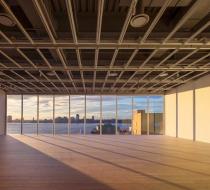Open Plan: Andrea Fraser at the Whitney Favorite
The average crow takes less than two hours to travel from Sing Sing maximum-security prison to the Whitney Museum of American Art, institutions separated by just 32 miles of land along New York’s Hudson river. Yet few humans journey between them – museums and prison are at opposite ends of our society’s self-imaginings, and their populations tend not to intersect.
The artist Andrea Fraser – provocateur, professor and performer who famously posed the question of whether art is, metaphorically, prostitution by sleeping with a collector on camera in Untitled (2003) – will focus on the relationship between galleries and jails in a new site-specific project opening at the Whitney on Friday. It will be the first in a series of rotating exhibitions, Open Plan, whereby the museum turns over to artists its immense fifth floor – a 18,200 sq ft, column-free space with sweeping views of the Hudson.
Fraser’s penetrating intellect is her medium of choice, and she uses it to tackle tough topics others would prefer to avoid (she is one of the few artists to have substantially engaged with post-recession income inequality, with the brilliant 2011 text L’1%, C’est Moi). Her Whitney project is called Down the River, a riff on the slang for convicts sent up the Hudson to Sing Sing. In it, she posits museums and prisons as “the bookend institutions of our increasingly polarised society – institutions that celebrate freedom, and institutions that revoke that freedom”.
“They’re really two sides of the coin of social inequality,” Fraser says over tea, taking a break from preparations for the show. “Museums increasingly are warehouses of wealth, capturing surplus in the form of artworks that are no longer financially productive. Prisons are institutions that warehouse surplus labour and populations that have been economically excluded from the labour market.” How, she asks, could our society be behind both “this incredible explosion of arts institutions and also this explosion of prisons and incarceration rates – which have gone up 700% since 1980 in the US?”
Visually, there will be nothing to see because Fraser is leaving the Whitney’s fifth floor empty. She wants to concentrate visitors’ attention on the ambient sounds of correctional facilities, which she recorded at institutions including Sing Sing. Her intention is not to create a spectacle of the prisoners for museum-goers (“God forbid”), but to put Whitney visitors “into the acoustic space of incarceration”.
The noise of a prison, she says, depend a lot on whether cells have doors or bars. Solid doors create a sound of silence: “You’re hearing the acoustics of an architecture of confinement and the apparatus of incarceration,” she says. “You’re hearing doors and footsteps and a big, hard, cold, empty, confined and containing space. You feel the dehumanisation of confinement through those sounds.”
At Sing Sing, where the cells have bars, prisoners are physically confined but their sounds travel. Unexpectedly, there is birdsong: “There hasn’t been a significant renovation since the 1920s, there is no air conditioning for example – and birds come in the windows, sparrows,” Fraser says. “We were told that the inmates feed the birds.” The sound blew her away, she says. “It’s like a European train station.”








